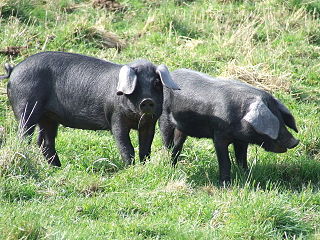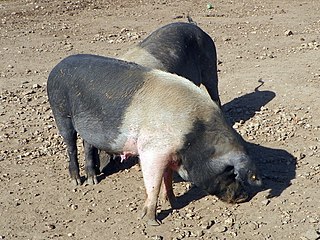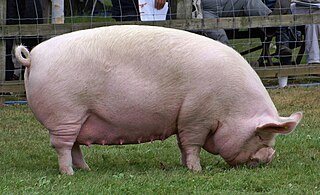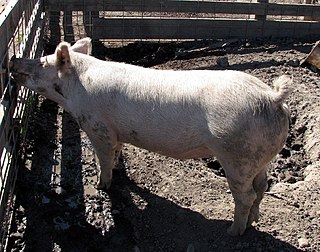Schleswig-Flensburg is a district in Schleswig-Holstein, Germany. It is bounded by the districts of Rendsburg-Eckernförde, Dithmarschen and Nordfriesland, the Region Syddanmark in Denmark, the city of Flensburg and the Baltic Sea.

Anglia is a small peninsula on the eastern coast of Jutland. Jutland consists of the mainland of Denmark and the northernmost German state of Schleswig-Holstein. Anglia belongs to the region of Southern Schleswig, which constitutes the northern part of Schleswig-Holstein, and protrudes into the Bay of Kiel of the Baltic Sea.

Holstein Friesians are a breed of dairy cattle that originated in the Dutch provinces of North Holland and Friesland, and Schleswig-Holstein in Northern Germany. They are known as the world's highest-producing dairy animals.

Vietnamese Pot-bellied is the exonym for the Lon I or I pig, an endangered traditional Vietnamese breed of small domestic pig.

The Tamworth, also known as Sandy Back and Tam, is a breed of domestic pig originating in its namesake Tamworth, Staffordshire United Kingdom. It is among the oldest of pig breeds, but as with many older breeds of livestock, it is not well suited to modern production methods and is listed as "Threatened" in the United States and "Vulnerable" in the UK by the Rare Breeds Survival Trust, as fewer than 300 registered breeding females remain. This animal is of ginger to red colouration and is thought to have descended from wild boars, via native pig stock of Europe. Principal populations today are in the United Kingdom, Australia, the United States, New Zealand, and Canada.

The Angeln is a breed of cattle originally from Angeln in Schleswig-Holstein where they are first mentioned around 1600. however some people think that they may have existed for over 5000 years. Breed management has been practiced since 1830. Angeln cattle are red in color and were one of the founders of the larger Danish Red Cattle breed. They are noted for the high milkfat level of their milk. Angeln cows produce an average 7570 kg (16,700 lb) of 4.81% fat milk.

The Pinzgauer is a breed of domestic cattle from the Pinzgau region of the federal state of Salzburg in Austria. It has distinctive colouring, with chestnut-brown sides and white back and underside. It was in the past a triple-purpose breed, raised for meat, milk and draught use. There is a naturally polled sub-type, the Jochberg Hummel. In 2007 the breed was not considered by the FAO to be at risk.

The Bentheim Black Pied, also known as Schwarz-Wesses or Buntes Bentheimer Schwein, is a rare breed of domestic pig in Germany.

The Essex is a breed of domestic pig originating in the United Kingdom.
Red Gorbatov cattle are a dairy cattle breed from Gorbatov, Russia.

The Wessex Saddleback or Wessex Pig is a breed of domestic pig originating in the West Country of England, (Wessex), especially in Wiltshire and the New Forest area of Hampshire. It is black, with white forequarters. In Britain it was amalgamated with the Essex pig to form the British Saddleback, and it is extinct as a separate breed in Britain. However, the Wessex Saddleback survives in Australia and New Zealand.

The Large Black pig is a British breed of domestic pig. It is the only British pig that is entirely black. It was created in the last years of the nineteenth century by merging the black pig populations of Devon and Cornwall in the south-west with those of Essex, Suffolk and Kent in the south-east. It is hardy, docile and prolific; it forages well and is suitable for extensive farming, but not well suited to intensive management.

The British Saddleback is a modern British breed of domestic pig. It was created in 1967 by merging the surviving populations of two traditional saddleback breeds, the Essex and Wessex Saddleback.

The Middle White is a British breed of domestic pig. It originated in Yorkshire, and derived from the Large White and the now-extinct Small White. It was recognised in 1852, and the first herd-book was published in 1884. It is a porker, reared for fresh pork, and is characterised by a short and sharply-upturned snout. After the Second World War it came close to extinction; although numbers have recovered somewhat, it is listed by the Rare Breeds Survival Trust as "priority" – the highest level of risk.

The Welsh is a breed of domestic pig native to Wales. It is a large white breed known for its hardiness in outdoor (extensive) farming, its long, pear-shaped body and its lop-ears. The breed was first mentioned in the 1870s, and after the Howitt committee report in 1955, became the third most common sire in the United Kingdom after the Large White pig and British Landrace pig. The Welsh pig experienced a decline in numbers in the late twentieth century because consumer demands had changed and the carcase was considered too fatty. In 2005 the breed was considered endangered and later came under the auspices of the Rare Breeds Survival Trust. Since then numbers have expanded somewhat, and by 2012, the registered breeding herd had increased to over 1000 animals.

The Husum Red Pied is a rare breed of domestic pig with the nickname Danish Protest pig. It originates from North Frisia in Southern Schleswig in the beginning of the 20th century, when Danes living in the area under Prussian rule were prohibited from raising the Danish flag and displayed the Protest Pig instead. Due to its red color, its broad white vertical belt, and a trace of a white horizontal belt resembling the colors of the flag of Denmark, it was made a symbol of their cultural identity.

The Australian Yorkshire is a breed of domestic pig from Australia that was originally a part of the Yorkshire breed of pigs from Yorkshire, England. It is said to be the most common and popular breed of pig in Australia due to economic and nutritional advantages.

The Gesellschaft zur Erhaltung alter und gefährdeter Haustierrassen or GEH is a German national association for the conservation of historic and endangered domestic animal breeds.

Krškopolje pig or Black-belted pig is an autochthonous breed of pig, originating in Slovenia. This pig represents the only still preserved Slovenian autochthonous breed of domestic pig. The easily recognizable blackish Krškopolje pig, widely used for meat production, is well known for its continuous pink belt, running across animal's shoulders and forelimbs.

















